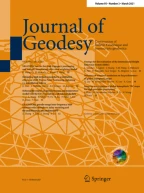Abstract
GPS satellite orbits available from the International GNSS Service (IGS) show a consistent radial bias of up to several cm and a particular pattern in the Satellite Laser Ranging (SLR) residuals, which are suggested to be related to radiation pressure mismodeling. In addition, orbit-related frequencies were identified in geodetic time series such as apparent geocenter motion and station displacements derived from GPS tracking data. A potential solution to these discrepancies is the inclusion of Earth radiation pressure (visible and infrared) modeling in the orbit determination process. This is currently not yet considered by all analysis centers contributing to the IGS final orbits. The acceleration, accounting for Earth radiation and satellite models, is introduced in this paper in the computation of a global GPS network (around 200 IGS sites) adopting the analysis strategies from the Center for Orbit Determination in Europe (CODE). Two solutions covering 9 years (2000–2008) with and without Earth radiation pressure were computed and form the basis for this study. In previous studies, it has been shown that Earth radiation pressure has a non-negligible effect on the GPS orbits, mainly in the radial component. In this paper, the effect on the along-track and cross-track components is studied in more detail. Also in this paper, it is shown that Earth radiation pressure leads to a change in the estimates of GPS ground station positions, which is systematic over large regions of the Earth. This observed “deformation” of the Earth is towards North–South and with large scale patterns that repeat six times per GPS draconitic year (350 days), reaching a magnitude of up to 1 mm. The impact of Earth radiation pressure on the geocenter and length of day estimates was also investigated, but the effect is found to be less significant as compared to the orbits and position estimates.
Similar content being viewed by others
References
Bar-Sever Y, Davis JL, Dach R, Flohrer C, Herring T, Ray J, Slater JA, Thaller D (2009) Impact of SLR tracking on GPS. In: Pavlis EC (ed) International Technical Laser Workshop on SLR Tracking of GNSS Constellations, http://acc.igs.org/orbits/slr_track_gps_ilrs09-PP.pdf, Position Paper
Bar-Sever YE (1996) A new model for GPS yaw attitude. J Geod 70(11): 714–723. doi:10.1007/BF00867149
Beutler G, Brockmann E, Gurtner W, Hugentobler U, Mervart L, Rothacher M, Verdun A (1994) Extended orbit modeling techniques at the CODE processing center of the international GPS service for geodynamics (IGS): theory and initial results. Manuscr Geod 19(6): 367–386
Collilieux X, Altamini Z, Coulot D, Ray J, Sillard P (2007) Comparison of very long baseline interferometry, GPS, and satellite laser ranging height residuals from ITRF2005 using spectral and correlation methods. J Geophys Res 112(B12403). doi:10.1029/2007JB004933
Dach R, Hugentobler U, Fridez P, Meindl M (2007) Bernese GPS Software Version, 5.0. Astronomical Institute, University of Bern
Dow J, Neilan R, Rizos C (2009) The International GNSS Service in a changing landscape of Global Navigation Satellite Systems. J Geod 83(3–4): 191–198. doi:10.1007/s00190-008-0300-3
Ferland R (2006) [IGSMAIL-5455]: IGS05 fine tuning. http://igscb.jpl.nasa.gov/mail/igsmail/2006/msg00178.html
Fliegel H, Gallini T (1996) Solar force modeling of block IIR global positioning system satellites. J Spacecr Rockets 33(6): 863–866. doi:10.2514/3.26851
Fliegel H, Gallini T, Swift E (1992) Global positioning system radiation force model for geodetic applications. J Geophys Res 97(B1): 559–568. doi:10.1029/91JB02564
Hugentobler U, van der Marel H, Springer T (2006) Identification and mitigation of GNSS errors. In: Springer T, Gendt G, Dow JM (eds) The International GNSS Service (IGS): Perspectives and Visions for 2010 and beyond, IGS Workshop 2006
Knocke PC, Ries JC, Tapley BD (1988) Earth radiation pressure effects on satellites. In: Proceedings of AIAA/AAS Astrodynamics Conference, pp 577-587
Kouba J (2009) A simplified yaw-attitude model for eclipsing GPS satellites. GPS Solut 13(1): 1–12. doi:10.1007/s10291-008-0092-1
Milani A, Nobili AM, Farinella P (1987) Non-Gravitational Perturbartions and Satellite Geodesy. Adam Hilger, Bristol
Press W, Teukolsky S, Vetterling W, Flannery B (1992) Numerical Recipes in Fortran 77: The Art of Scientific Computing, 2nd edn. Cambridge University Press, Cambridge
Ray J, Altamini Z, Collilieux X, Dam T (2008) Anomalous harmonics in the spectra of GPS position estimates. GPS Solut 12(1): 55–64. doi:10.1007/s10291-007-0067-7
Rodriguez-Solano CJ (2009) Impact of albedo modelling on GPS orbits. Master’s thesis, Technische Universität München. http://mediatum2.ub.tum.de/doc/1083571/1083571.pdf
Rodriguez-Solano CJ, Hugentobler U, Steigenberger P (2010) Impact of Albedo Radiation on GPS Satellites. In: Geodesy for Planet Earth, International Association of Geodesy Symposia. Springer, Berlin (in press)
Scargle J (1982) Studies in astronomical time series analysis. II. statistical aspects of spectral analysis of unevenly spaced data. Astrophys J 263: 835–853. doi:10.1086/160554
Steigenberger P, Rothacher M, Dietrich R, Fritsche M, Rülke A, Vey S (2006) Reprocessing of a global GPS network. J Geophys Res 111(B05402). doi:10.1029/2005JB003747
Steigenberger P, Hugentobler U, Lutz S, Dach R (2011) CODE Contribution to the First IGS Reprocessing Campaign. Tech. Rep. 1/2011, IAPG/TUM. http://mediatum2.ub.tum.de/doc/1078108/1078108.pdf
Tregoning P, Watson C (2009) Atmospheric effects and spurious signals in GPS analysis. J Geophys Res 114, B09403. doi:10.1029/2009JB006344
Urschl C, Beutler G, Gurtner W, Hugentobler U, Schaer S (2007) Contribution of SLR tracking data to GNSS orbit determination. Adv Space Res 39: 1515–1523. doi:10.1016/j.asr.2007.01.038
Wielicki BA, Barkstrom BR, Harrison EF, Lee RB III, Smith GL, Cooper JE (1996) Clouds and the Earth’s Radiant Energy System (CERES): an Earth observing system experiment. Bull Am Meteorol Soc 77(5): 853–868
Ziebart M, Edwards S, Adhya S, Sibthorpe A, Arrowsmith P, Cross P (2004) High precision GPS IIR orbit prediction using analytical non-conservative force models. In: Proceedings of ION-GNSS-2004, pp 1764–1770
Ziebart M, Sibthorpe A, Cross P, Bar-Sever Y, Haines B (2007) Cracking the GPS–SLR Orbit Anomaly. In: Proceedings of ION-GNSS-2007, pp 2033–2038
Author information
Authors and Affiliations
Corresponding author
Rights and permissions
About this article
Cite this article
Rodriguez-Solano, C.J., Hugentobler, U., Steigenberger, P. et al. Impact of Earth radiation pressure on GPS position estimates. J Geod 86, 309–317 (2012). https://doi.org/10.1007/s00190-011-0517-4
Received:
Accepted:
Published:
Issue Date:
DOI: https://doi.org/10.1007/s00190-011-0517-4
